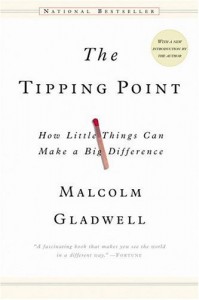What does it take to create a tipping point?
The three rules of epidemic:
1) The law of the few:
a)Connectors – Paul Revere is a connector – that’s how he was effective in bringing awareness to the Boston people the imminent British invasion. The other less famous guy William Dawes wasn’t effective. Paul Revere possess “social gifts.” We’re all connected by “six degrees of separation.” But all degrees are the same. The connectors know a lot people, and the critical kinds of people they know, masterful of the “weak ties” (acquaintances).
b) Mavens, who accumulates knowledge, “who solves his own problems – his own emotional needs – by solving other people’s problem. They are not persuaders; they are teachers. Mavens start the Hush Puppies phenomenon. The 800 number on a product is often used as the maven trap.
c) Salesmen, e.g. Tom Gau in Torrance. It could be very subtle cues like head nodding (Peter Jenninings’s smile when Ronald Reagan is mentioned), and other “micro-movements” like dancing, and “seducing” – building a level of trust and rapport.
2) The stickiness factor
Stickiness of message: Sesame Street vs. Blue’s Clues (repetition, long narrative, getting pre-schooler’s attention). Here, Gladwell went into the beginning of the Sesame Street and the contrast with Blue’s Clues. Interesting and anecdotal but not very informative.
3) The power of context.
Author started with Bernhard Goetz’s story and how he became a symbol of the a particular, dark moment in New York. By practicing the “Broken Window Theory” and cleaning up the graffiti on trains and train stations – the context, New York City Transit, headed by David Gunn, started a transformation that reduces the crime rate drastically in the 80’s. “Behavior is a function of social context.” The mock prison experiment was revealing that “specific situations are so powerful that they can overwhelm our inherent predispositions.” We tend to make the mistake of “overestimating the importance of fundamental character traits and underestimating the importance of the situation and context.” The “Good Samaritan experiment” on the students of a seminary is an interesting example of the power of context. Ya-ya sisterhood started with many small groups (book clubs) then evolve into a social phenomenon. The magic number of 150 – a maximum number (“social channel capacity”) an organization or group can reach without losing its effectiveness. This can be attributed to the evolution, the larger the group size and larger the neocortex is.
The case studies: Airwalk shoes, crossing the chasm (technology) – diffusion model, the suicide epidemic on the Micronesia islands, teenager smoking, and etc.
I’ve listened to this audio book twice and briefly browsed the book. I’ve learned quote a few things about how to create an epidemic. This is great for marketing people who want to create a social phenomenon; they need to pay attention to the connectors, mavens, and salesmen and make their message sticky and create a context for their products and services. Very intriguing.
Wikipedia’s summary


